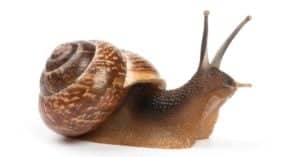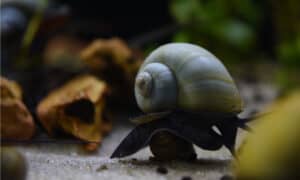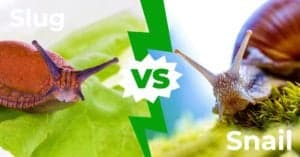
People want to own GALS because of their fascinating colors. However, they are illegal in the U.S.
©Olena Kurashova/Shutterstock.com
An invasive species is a non-native organism that is introduced to an area where it spreads without containment, with the potential to damage the environment, economy, or human health. Invasive species can be diseases, parasites, plants, and animals.
Florida is victim to several invasive species which threaten wildlife populations. News reports of Burmese pythons are the most common, but one species is slowly crawling through people’s yards and causing more damage than the pythons. Although this invasive species is incredibly slow, it is repopulating faster than local authorities can handle. Surprisingly, this invasive species is a snail!
Invasive Snail in Florida

Giant African snails are one of several invasive snail species in the US that damages crops.
©phototrip/iStock via Getty Images
Lissachatina fulica, the Giant African land snail, or GALS, is a large snail native to East Africa. On average, these snails can live three to five years in the wild. Some snails are capable of living up to nine years through routine hibernation. GALS can hibernate for up to one year, waiting for favorable environmental and weather conditions.
Giant African snails are hardy animals, capable of living in most environments. They prefer cold and damp locations to keep their bodies moist but can survive through some dry seasons thanks to hibernating. These snails are nocturnal, eating at night and sleeping during the day.
GALS possess both male and female reproductive organs, meaning they can procreate asexually. A single Giant African snail can lay between 100-500 eggs a year. The offspring hatch within 11-15 days and reach sexual maturity within eight to 12 months.
What Do GALS Look Like?
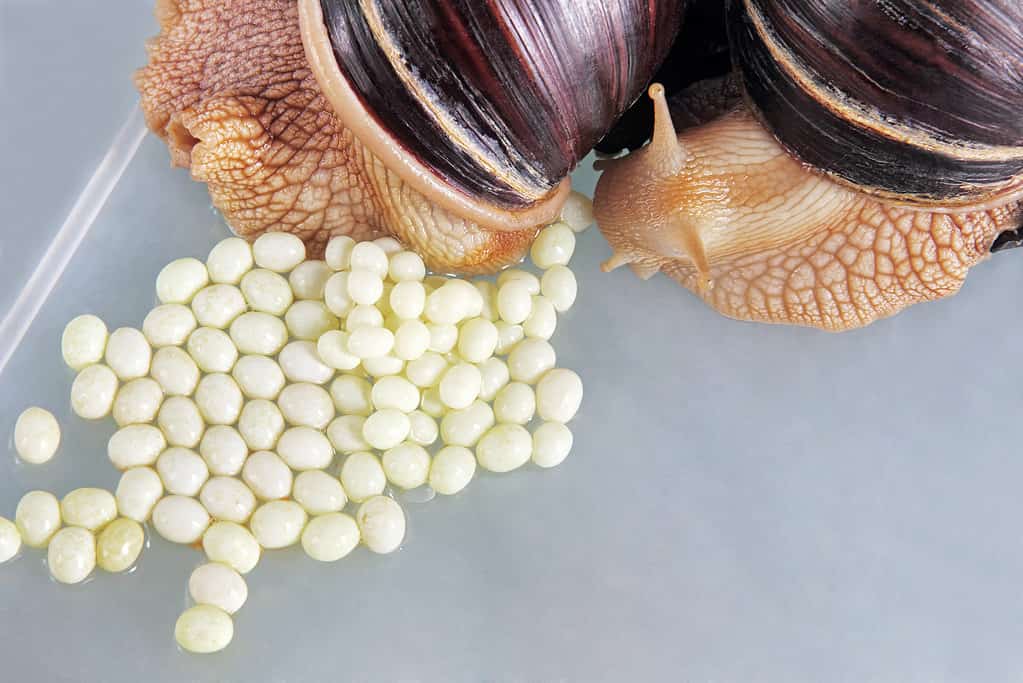
A single GAL can undo all the hard work of eradicating the species within a few months.
©Grotmarsel/iStock via Getty Images
Giant African snails are the world’s largest land mollusk. They can reach 8 inches long and carry a cone-shaped shell on their backs. Most GALS shells have cream-chocolate stripes on their whorls (spiral shape).
Giant African snail eggs are yellow-cream colored, and approximately ¼ inch in diameter. Eggs are laid underground or in deep vegetation.
How Did GALS Get to Florida?
The first GALS invasion started in the 1960s. They were most likely brought over as illegal pets that were released into the wild. Without any natural predators and with high reproduction levels, the snails reproduced throughout several counties. Government and local authorities eradicated the invasive species at the time.
In 2011, a religious group brought more snails over to perform a religious ritual, claiming the snails cured medical problems. The group was apprehended, and many snails needed to be relocated.
However, new reports from June 2022 and June 2023 indicate snail outbreaks in Broward, Lee, and Pasco counties. The three zones are in quarantine to prevent the snail’s spread while proper authorities eradicate the mollusks. Experts suspect their return is due to the illegal pet trade.
Are GALS Dangerous to Humans?
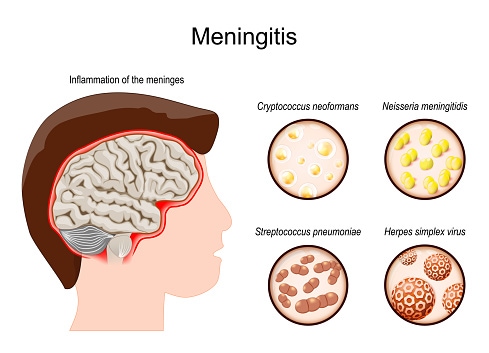
Meningitis is the inflammation of the meninges.
©ttsz/iStock via Getty Images
Giant African snails do not pose a direct threat to humans, but they pose a dangerous indirect threat. These snails carry rat lungworm parasites, which spread to humans and pets when eaten. Handling a snail without safety procedures like wearing gloves or thoroughly washing hands, may lead to accidentally ingesting the parasite. Alternatively, ingesting food that a snail infects may also lead to infection. Pets devouring a snail with the parasite will become infected as well.
Angiostrongyliasis, or rat lungworm, is a disease that affects the brain and spinal cord, leading to meningitis (inflammation of the surrounding brain and spinal cord tissue).
Symptoms of meningitis include:
- Nausea
- Vomiting
- Abdominal pain
- Headaches
- Stiffness
- Fever
- Fatigue
- Pain
- Blurred vision
- Bladder problems
- Seizures
The Hawaii Department of Health on Disease Outbreak and Control reports that humans are at a low risk of contracting the disease. The parasite cannot survive well in human hosts, eventually dying off. Hawaii is another state suffering from the snails invading their islands.
Regardless, individuals should seek medical attention if they believe they are infected.
How Dangerous Are GALS to the Environment

Groups of GALS can ruin a farm through sheer numbers and high reproduction rates.
©Elen Marlen/iStock via Getty Images
The Giant African snail can decimate crops and vegetation. They eat 500 different types of plants, making them a massive threat to agriculture. Also, because they infect other crops with their parasites, they may cause outbreaks of rat lungworm in humans or pets.
They lay hundreds of eggs in a single year and can hibernate for months without detection. A single Giant African snail can undo all the laborious hours and meticulous work of dozens within a few months.
When food is short, GALS will eat plastic, ornamental plants, and stucco. Stucco is a construction material that applies to wet and hardened surfaces. It is excellent for wall decoration, ceilings, sculptures, and architecture. Too many snails feeding on stucco may damage the interior of a home or office.
To prevent the snails from spreading, counties with positive sightings of the snails must go into quarantine until the outbreak is contained.
Dealing with GALS in Florida
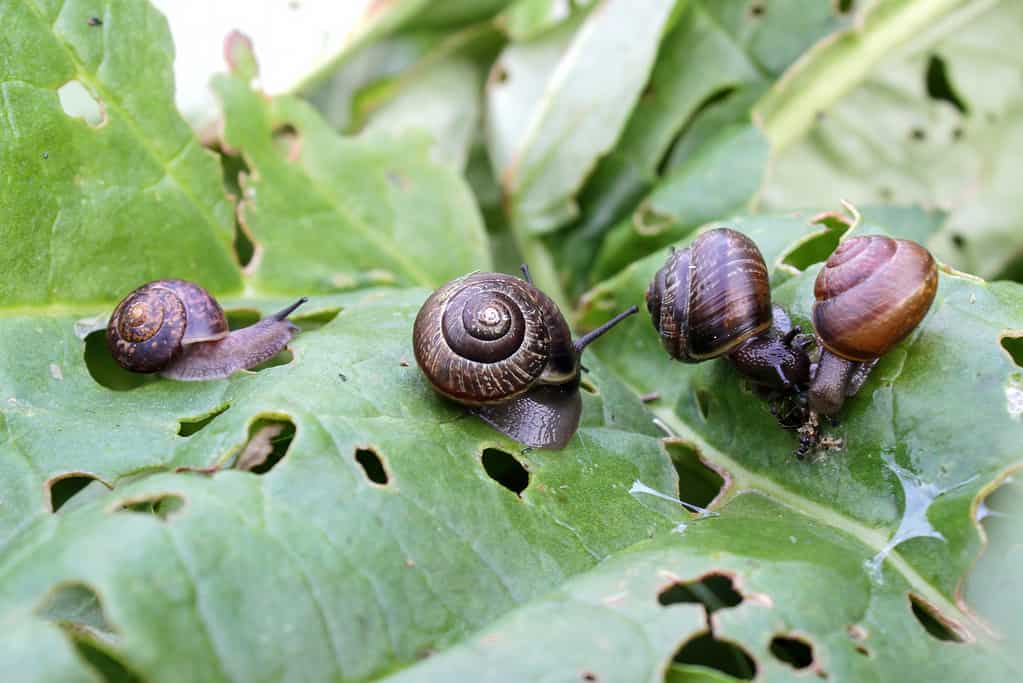
Garden snails are native to the U.S. but are equally problematic to farmers.
©VitaSerendipity/iStock via Getty Images
Due to their rapid growth in population and susceptibility to the spread disease, locals must use caution when handling or working around these snails. As previously mentioned, Broward, Lee, and Pasco counties are in quarantine, but other locations like Hawaii and the Caribbean are also infested.
When encountering a Giant African snail, follow these guidelines:
- Do not touch them. Avoid direct contact with the snail in case it is contaminated with rat lungworm.
- Contact the local authorities or the state’s department of agriculture or conservation. For instance, Florida residents may contact a helpline at 1-888-397-1517 or email [email protected]. When emailing a snail sighting, please submit its location with corresponding photos for verification.
- Do not purchase GALS online or at pet stores. Giant African snails are illegal to own because of the damage they cause to agriculture and health risks to humans. These snails are being sold illegally and any location harboring them should be reported to authorities immediately.
- If an individual owns a Giant African snail and wishes to give up ownership, they should seek out animal shelters or find exotic animal amnesty days. On amnesty days, local officials confiscate illegal or exotic animals from owners without risk of legal repercussions. The officials relocate the animals to a suitable habitat.
Other Invasive Species in Florida
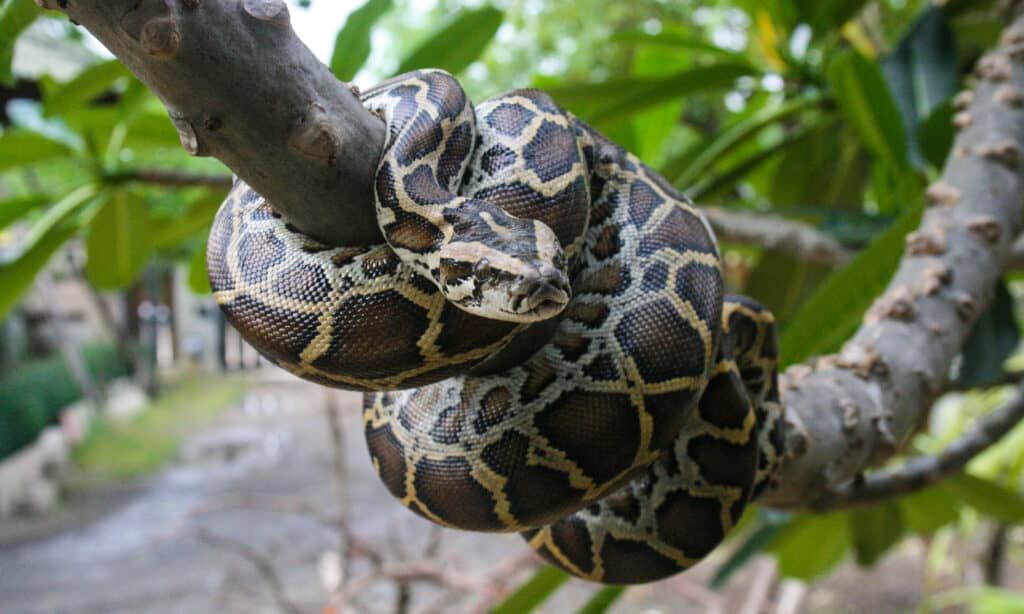
Burmese pythons grow so large that they are capable of eating adult
alligators
.
©iStock.com/Lunatic_67
Unfortunately, there are several invasive species across Florida damaging the environment.
Several examples of invasive species in Florida are:
Burmese pythons
Burmese pythons are the most well-known and concerning species in Florida. They grow between 15-22 feet long and devour all native wildlife without any predators capable of managing their increasing population.
Lionfish
Lionfish are fish with long, red, and white stripes covering their body. They have 12 long venomous spines lining their dorsal fins to prevent handling or predator attacks. These spines cause severe and throbbing pain, capable of lasting for 12 hours without treatment. Lionfish are devouring the native reef life off the Florida coasts which are harming the coral reef and reducing native fish populations.
Cane Toads
Cane toads are legal to own in Florida without a permit but are dangerous when left to roam in the wild. Their skin secretes a highly toxic substance (bufotoxin) which can cause sickness to any animal trying to eat it. Some cases report the toxin being lethal to native animals and domestic pets. The toad’s eggs also possess bufotoxin, making them dangerous to consume as well. Handling them without proper gear may irritate humans.
Brazilian Pepper Tree
The Brazilian pepper tree is an evergreen shrub or small tree that was brought to Florida in the 1800s as decoration. However, the shrub has since spread across the state, displacing other trees because of its rapid growth, high germination rate, and wide environmental tolerances.
Water-Hyacinth
These are floating plants that cluster together to form dense rafts or dams. The plant itself is beautiful, but it possesses an extraordinarily high growth rate which damages local wildlife. Water-hyacinths dissolve oxygen concentration in waterways, harming fish populations, increasing chances of flooding, and increasing mosquitos in the area.
Protect local wildlife by reporting illegal pet trade operations and by contacting the US Department of Agriculture when handling an invasive species.
The photo featured at the top of this post is © Mark Brandon/Shutterstock.com
Thank you for reading! Have some feedback for us? Contact the AZ Animals editorial team.




